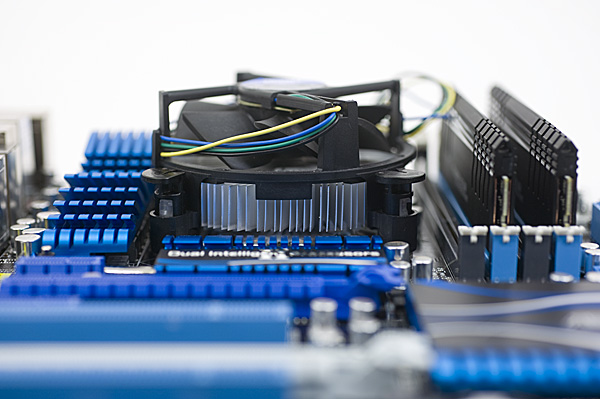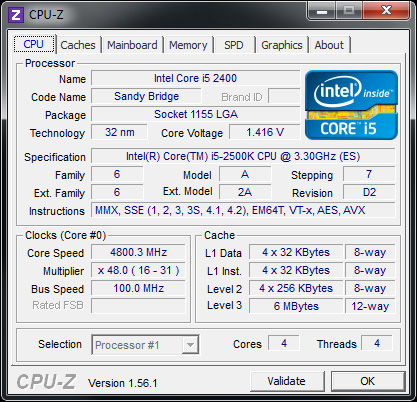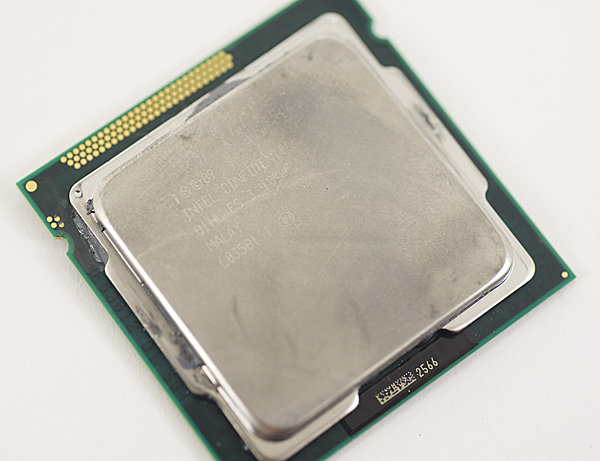The Sandy Bridge Review: Intel Core i7-2600K, i5-2500K and Core i3-2100 Tested
by Anand Lal Shimpi on January 3, 2011 12:01 AM ESTOverclocking, the K-Series and What You’ll Want to Buy
If you haven’t noticed, the computing world is becoming more integrated. We review highly integrated SoCs in our smartphone coverage, and even on the desktop we’re seeing movement towards beefy SoCs. AMD pioneered the integrated memory controller on desktop PCs, Intel followed suit and with Lynnfield brought a PCIe controller on-die as well. Sandy Bridge takes the next logical step and brings a GPU on-die, a move matched by AMD with Brazos and Llano this year.
In the spirit of integration, Intel made one more change this round: the 6-series chipsets integrate the clock generator. What once was a component on the motherboard, the PLL is now on the 6-series chipset die. The integrated PLL feeds a source clock to everything from the SATA and PCIe controllers to the SNB CPU itself. With many components driven off of this one clock, Intel has locked it down pretty tight.
With Nehalem and Westmere, to overclock you simply adjusted the BCLK from 133MHz to whatever speed you wanted and sometimes toyed with multipliers to arrive at a happy end result. With Sandy Bridge, the BCLK generated on the 6-series PCH is at 100MHz by default and honestly won’t go much higher than that.
While I’ve heard reports of getting as high as 115MHz, I’d view 103—105MHz as the upper limit for what you’re going to get out of BCLK overclocking. In other words: next to nothing. A 105MHz BCLK overclock on a Core i7-2600 will take you from a stock speed of 3.4GHz to a whopping 3.57GHz. The form of overclocking we’ve been using for the past decade is effectively dead on Sandy Bridge.
Years ago, before the Pentium II, we didn’t rely on BCLK (or back then it was just FSB or bus overclocking) to overclock. Back then, if we wanted a faster CPU we’d just increase the clock multiplier. Intel has dabbled in offering multiplier unlocked parts for overclockers, we saw this last year with the Core i7 875K for example. With Sandy Bridge, those unlocked parts are going to be a lot more important to overclockers.
It works like this. If you have a part that does not support Turbo (e.g. Core i3-2100 series), then your CPU is completely clock locked. You can’t overclock it at all, have fun at your stock frequency. This is good news for AMD as it makes AMD even more attractive at those price points.
If you have a part that does support turbo (e.g. Core i5-2400), then you have what’s called a “limited unlocked” core—in other words you can overclock a little bit. These parts are limited to an overclock of 4 processor bins above and beyond the highest turbo frequency. Confused yet? This chart may help:
In this case we’re looking at a Core i5-2500, which runs at 3.3GHz by default. When a single core is active, the chip can turbo up to 3.7GHz. If you want, you can change that turbo state to go as high as 4.1GHz (if your CPU and cooling can keep up).
Overclocking these limited unlocked chips relies entirely on turbo however. In the case above, the fastest your chip will run is 4.1GHz but with only one core active. If you have four cores active the fastest your chip can run is 3.8GHz. While Intel didn’t sample any limited unlocked parts, from what I’ve heard you shouldn’t have any problems hitting these multiplier limits.
There’s a third class of part: a fully unlocked K-series chip. At launch there are only two of these processors: the Core i5-2500K and the Core i7-2600K. Anything with a K at the end of it means you get all multipliers from 16x all the way up to 57x at your disposal. It’s effectively fully unlocked.

These chips overclock very well. Both my Core i5-2500K and Core i7-2600K hit ~4.4GHz, fully stable, using the stock low-profile cooler.

This is all you need for 4.4GHz
With a bit more effort and a better cooler, you can get anywhere in the 4.6-5.0GHz range:

It's a bit too early to tell how solid these near-5GHz overclocks will be, but I'm confident in the sub-4.5GHz overclocks we were able to sustain.
You do pay a price premium for these K-series SKUs. The 2500K will cost you another $11 over a stock 2500 and the 2600K costs an extra $23. In the case of the 2500K, that’s a small enough premium that it’s honestly worth it. You pay $11 extra for a chip that is very conservatively clocked and just begging for you to overclock it. Even the 2600K’s premium isn’t bad at all.
| Model Number | Standard SKU | K-Series SKU | Price Premium |
| Intel Core i7-2600 | $294 | $317 | +$23 |
| Intel Core i5-2500 | $205 | $216 | +$11 |
As an added bonus, both K-series SKUs get Intel’s HD Graphics 3000, while the non-K series SKUs are left with the lower HD Graphics 2000 GPU.
Compared to Lynnfield, you’re paying $11 more than a Core i5-760 and you’re getting around 10-45% more performance, even before you overclock. In a perfect world I’d want all chips to ship unlocked; in a less perfect world I’d want there to be no price premium for the K-series SKUs, but at the end of the day what Intel is asking for here isn’t absurd. On the bright side, it does vastly simplify Intel’s product stack when recommending to enthusiasts: just buy anything with a K at the end of it.
Since we’re relying on multiplier adjustment alone for overclocking, your motherboard and memory actually matter less for overclocking with Sandy Bridge than they did with P55. On both P67 and H67, memory ratios are fully unlocked so you can independently set memory speed and CPU speed. Even the GPU ratios are fully unlocked on all platforms and fully independent from everything else.












283 Comments
View All Comments
auhgnist - Monday, January 17, 2011 - link
For example, between i3-2100 and i7-2600?timminata - Wednesday, January 19, 2011 - link
I was wondering, does the integrated GPU provide any benefit if you're using it with a dedicated graphics card anyway (GTX470) or would it just be idle?James5mith - Friday, January 21, 2011 - link
Just thought I would comment with my experience. I am unable to get bluray playback, or even CableCard TV playback with the Intel integrated graphics on my new I5-2500K w/ Asus Motherboard. Why you ask? The same problem Intel has always had, it doesn't handle the EDID's correctly when there is a receiver in the path between it and the display.To be fair, I have an older Westinghouse Monitor, and an Onkyo TX-SR606. But the fact that all I had to do was reinstall my HD5450 (which I wanted to get rid of when I did the update to SandyBridge) and all my problems were gone kind of points to the fact that Intel still hasn't gotten it right when it comes to EDID's, HDCP handshakes, etc.
So sad too, because otherwise I love the upgraded platform for my HTPC. Just wish I didn't have to add-in the discrete graphics.
palenholik - Wednesday, January 26, 2011 - link
As i could understand from article, you have used just this one software for all these testings. And I understand why. Is it enough to conclude that CUDA causes bad or low picture quality.I am very interested and do researches over H.264 and x264 encoding and decoding performance, especially over GPU. I have tested Xilisoft Video Converter 6, that supports CUDA, and i didn't problems with low quality picture when using CUDA. I did these test on nVidia 8600 GT and for TV station that i work for. I was researching for solution to compress video for sending over internet with low or no quality loss.
So, could it be that Arcsoft Media Converter co-ops bad with CUDA technology?
And must notice here how well AMD Phenom II x6 performs well comparable to nVidia GTX 460. This means that one could buy MB with integrated graphics and AMD Phenom II x6 and have very good encoding performances in terms of speed and quality. Though, Intel is winner here no doubt, but jumping from sck. to sck. and total platform changing troubles me.
Nice and very useful article.
ellarpc - Wednesday, January 26, 2011 - link
I'm curious why bad company 2 gets left out of Anand's CPU benchmarks. It seems to be a CPU dependent game. When I play it all four cores are nearly maxed out while my GPU barely reaches 60% usage. Where most other games seem to be the opposite.Kidster3001 - Friday, January 28, 2011 - link
Nice article. It cleared up much about the new chips I had questions on.A suggestion. I have worked in the chip making business. Perhaps you could run an article on how bin-splits and features are affected by yields and defects. Many here seem to believe that all features work on all chips (but the company chooses to disable them) when that is not true. Some features, such as virtualization, are excluded from SKU's for a business reason. These are indeed disabled by the manufacturer inside certain chips (they usually use chips where that feature is defective anyway, but can disable other chips if the market is large enough to sell more). Other features, such as less cache or lower speeds are missing from some SKU's because those chips have a defect which causes that feature to not work or not to run as fast in those chips. Rather than throwing those chips away, companies can sell them at a cheaper price. i.e. Celeron -> 1/2 the cache in the chip doesn't work right so it's disabled.
It works both ways though. Some of the low end chips must come from better chips that have been down-binned, otherwise there wouldn't be enough low-end chips to go around.
katleo123 - Tuesday, February 1, 2011 - link
It is not expected to compete Core i7 processors to take its place.Sandy bridge uses fixed function processing to produce better graphics using the same power consumption as Core i series.
visit http://www.techreign.com/2010/12/intels-sandy-brid...
jmascarenhas - Friday, February 4, 2011 - link
Problem is we need to choose between using integrated GPU where we have to choose a H67 board or do some over clocking with a P67. I wonder why we have to make this option... this just means that if we dont do gaming and the 3000 is fine we have to go for the H67 and therefore cant OC the processor.....jmascarenhas - Monday, February 7, 2011 - link
and what about those who want to OC and dont need a dedicated Graphic board??? I understand Intel wanting to get money out of early adopters, but dont count on me.fackamato - Sunday, February 13, 2011 - link
Get the K version anyway? The internal GPU gets disabled when you use an external GPU AFAIK.